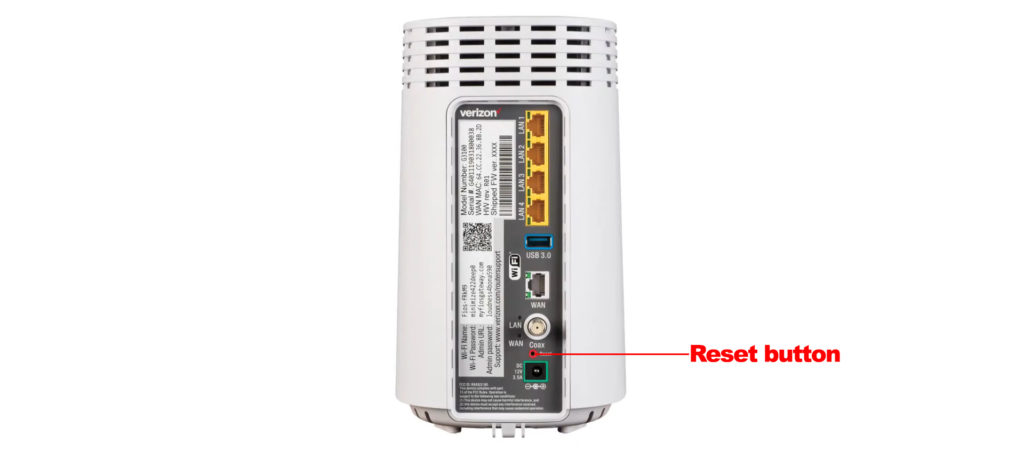Experiencing slow internet speeds, dropped Wi-Fi connections, or other network glitches with your Verizon Fios or 5G/LTE Home Internet service? Often, a simple router reset or reboot can resolve these common issues. However, it’s important to understand the difference between restarting your router and performing a full factory reset, as they have very different outcomes. This guide explains how to reset verizon router equipment.

Why Reset Your Router?
You might need to restart or reset your Verizon router for several reasons:
- Troubleshooting: To fix slow speeds, intermittent connectivity, or issues where devices can’t connect to Wi-Fi.
- Clearing Glitches: Like any electronic device, routers can benefit from a refresh to clear temporary software hiccups or memory issues.
- Forgotten Passwords: If you’ve forgotten your custom Wi-Fi password or the router’s admin password, a factory reset might be necessary.
- Starting Fresh: To erase all custom configurations and return the router to its out-of-the-box state.
Reboot (Restart) vs. Factory Reset: Know the Difference
Before you proceed, understand the two main types of “resets”:
Reboot (Power Cycle)
- What it is: Simply turning the router off and then back on again.
- Effect: Clears the router’s temporary memory and restarts its processes. It does NOT erase your settings like your Wi-Fi name (SSID), password, or other configurations.
- When to Use: This should almost always be your first troubleshooting step for common connectivity problems.
Read more about: cancel verizon service
Factory Reset
- What it is: Restoring the router to its original, default manufacturer settings.
- Effect: Erases ALL custom configurations, including your personalized Wi-Fi network name (SSID), Wi-Fi password, admin password changes, port forwarding rules, and any other network settings you’ve adjusted.
- When to Use: Use this as a later troubleshooting step if rebooting doesn’t help, if you’re locked out due to forgotten passwords, if you suspect incorrect configurations are causing major problems, or if instructed by Verizon support. Also necessary before returning rented equipment.
How to Reboot Your Verizon Router (Power Cycle)
This simple process often resolves minor issues:
- Unplug Power: Locate the power cord connected to your Verizon router and unplug it from the wall outlet or the back of the router itself.
- Wait: Leave the router unplugged for about 30 to 60 seconds. This ensures it fully powers down.
- Plug In: Plug the power cord back into the router and the wall outlet.
- Wait for Restart: Allow several minutes for the router to fully boot up, establish its connection, and for the status lights to stabilize (often solid white or green, depending on the model). Test your connection afterward.
How to Perform a Factory Reset Verizon Router
Warning: Remember, this process will erase all your personalized settings. You will need to set up your Wi-Fi network again afterward.
- Locate the Reset Button: While the router is powered ON, find the physical reset button. It’s typically a small, recessed pinhole located on the back or bottom panel of the router. You will likely need a paperclip, pin, or similar thin object to press it.
- Press and Hold: Insert the paperclip into the reset pinhole and press and hold the button down firmly.
- Hold Duration: Continue holding the button for at least 10-15 seconds. (Some specific models might vary slightly, but 10-15 seconds is standard for a factory reset. Holding it for only 3 seconds might just perform a reboot on some models).
- Release and Wait: Release the button. The router’s lights will likely flash or change color as it begins the reset and reboot process. This can take several minutes. Wait until the status lights indicate it has fully restarted and established a connection (often solid white or green).
After a Factory Reset: Reconfiguration Needed
Once you factory reset verizon router equipment, it returns to its default state:
- Default Wi-Fi: Your custom Wi-Fi network name (SSID) and password will be gone. The router will broadcast its original default network name and use the default password.
- Find Defaults: Look for a sticker on the router itself (usually on the back or bottom) which lists the default Wi-Fi Name (SSID) and default Wi-Fi Password.
- Reconnect: Connect a computer or phone to this default Wi-Fi network (or use an Ethernet cable).
- Re-Configure: Open a web browser and navigate to the router’s admin interface (the address, like mynetworksettings.com or an IP address like 192.168.1.1, is often on the sticker too). Log in using the default admin username/password (also usually on the sticker). Follow the setup prompts to change the Wi-Fi network name (SSID) and create a new, strong Wi-Fi password. Re-apply any other custom settings (like port forwarding) if needed.
- Reconnect Devices: Update the Wi-Fi settings on all your wireless devices (phones, laptops, smart TVs, cameras, etc.) to connect to your newly configured network name and password.
Alternative Troubleshooting
Before resorting to a factory reset, consider:
- My Verizon App/Website: Use the troubleshooting tools available within your My Verizon account, which can often diagnose and fix issues remotely.
- Contacting Support: If a simple reboot doesn’t solve the problem, contacting Verizon technical support is often a better next step than immediately performing a factory reset, unless you specifically need to restore defaults (like for a forgotten password).


